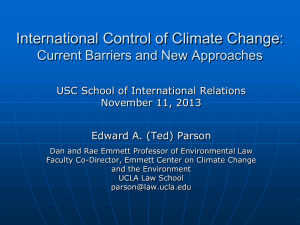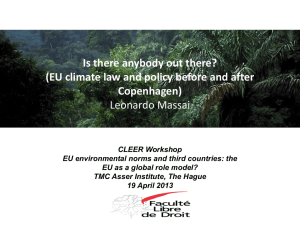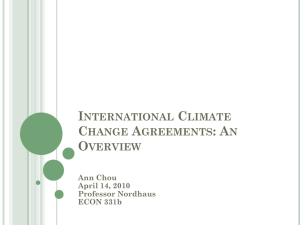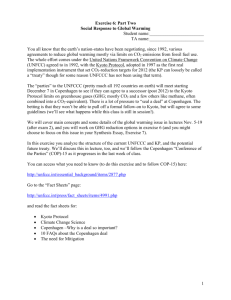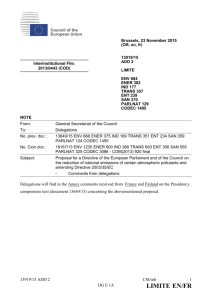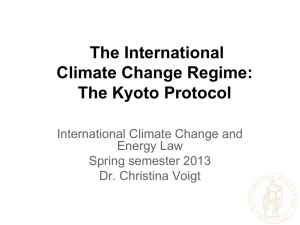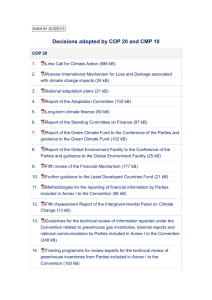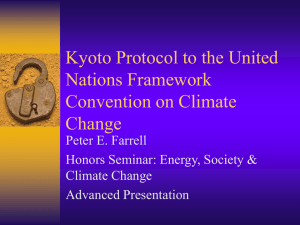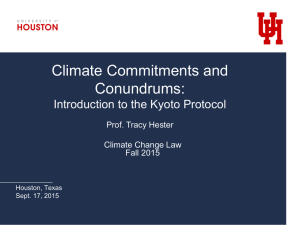Int. Climate Law Principles
advertisement
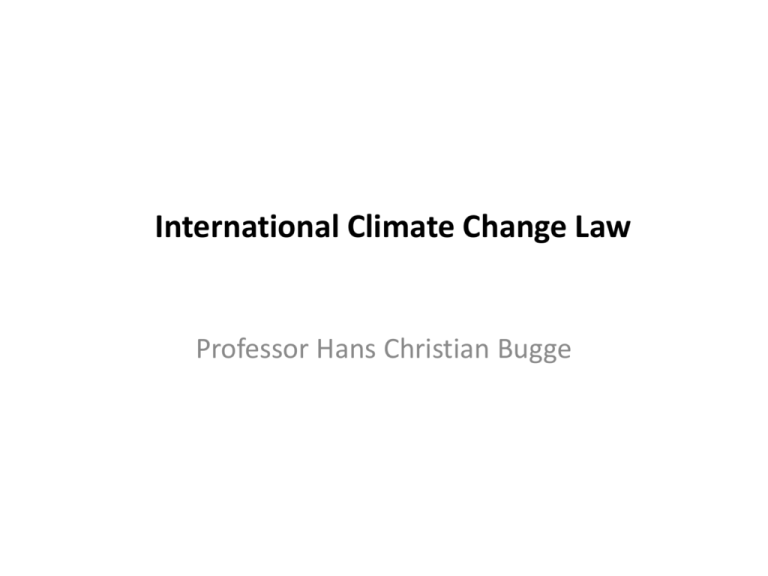
International Climate Change Law Professor Hans Christian Bugge The Greenhouse Effect Pakistan, 2010 floods Pakistan flood: Worst in 80 years, 14 million affected The other end of the spectrum: drought i Eastern Africa • guardian.co.uk, Monday 4 July 2011: “Drought in east Africa the result of climate change and conflict Aid agencies say that weather in the region has become more erratic and years of war leave populations especially vulnerable.” Greenland: areas (1992 orange and 2002 red) with seasonal melting at the surface of the ice sheet Male, capital of the Maldives IPCC Fourth Assessment Report 2007 • “Warming of the climate system is unequivocal, as is now evident from observations of increases in global average air and ocean temperature, widespread melting of snow and ice, and rising global mean sea levels.” • “Most of the observed increase in globally average temperatures since the mid-20th century is very likely due to the observed increase in anthropogenic greenhouse gas concentrations. “ • Discernible human influences now extend to other aspects of climate, including ocean warming, continental-average temperatures, temperature extremes and wind patterns.” IPCC Fourth Assessment Report 2007 The nature of the climate change problem • It is a global problem in the full meaning of the word, relevant to every state and people on the Planet: We all contribute and we all will be affected • There are extreme differences between states and peoples with regard to its contribution and effects. • The costs of relevant measures to solve it vary significantly between countries. • It is extremely complex because it is rooted in our civilization. It involves most economic sectors. Per capita responsibility for current anthropogenic CO2 level in the atmosphere, including land use change (until 2000). GHG emissions per capita 2005 Nicholas Stern: ”… the greatest and widest ranging market failure ever seen.” Legal status: • Common resource? • Shared resource? • Common heritage of mankind? • Common concern of humankind? FCCC article 2 Objective “The ultimate objective of this Convention and any related legal instruments that the Conference of the Parties may adopt is to achieve, in accordance with the relevant provisions of the Convention, stabilization of greenhouse gas concentrations in the atmosphere at a level that would prevent dangerous anthropogenic interference with the climate system. Such a level should be achieved within a time frame sufficient to allow ecosystems to adapt naturally to climate change, to ensure that food production is not threatened and to enable economic development to proceed in a sustainable manner.” Climate Change: Defining Options Climate Change Mitigation Adaptation FCCC article 3, section 4 The Parties have a right to, and should, promote sustainable development. Policies and measures to protect the climate system against human-induced change should be appropriate for the specific conditions of each Party and should be integrated with national development programmes, taking into account that economic development is essential for adopting measures to address climate change. FCCC, article 3, section 3 • “The Parties should take precautionary measures to anticipate, prevent or minimize the causes of climate change and mitigate its adverse effects. • Where there are threats of serious or irreversible damage, lack of full scientific certainty should not be used as a reason for postponing such measures, taking into account that policies and measures to deal with climate change should be cost-effective so as to ensure global benefits at the lowest possible cost. ...” …. To achieve this (cost-effectiveness), such policies and measures should take into account different socio-economic contexts, be comprehensive, cover all relevant sources, sinks and reservoirs of greenhouse gases and adaptation, and comprise all economic sectors. Efforts to address climate change may be carried out cooperatively by interested Parties.” Principle of Common but Differentiated Responsibilities, article 4 section 1 The Parties should protect the climate system for the benefit of present and future generations of humankind, on the basis of equity and in accordance with their common but differentiated responsibilities and respective capabilities. Accordingly, the developed country Parties should take the lead in combating climate change and the adverse effects thereof. ”Developed” and ”developing” countries • “Developed countries”: OECD countries (some 30 in all), 18 % of world population • “Developing countries”: “Group of 77 at the United Nations” (“G 77”) (now 131 in all, including China), 80 % of world population (Some 30 countries are outside both these groupings.) But not consistent categorization across international conventions Groups of (developing) countries (art. 4 no 8-10). • Small island countries; • Countries with low-lying coastal areas; • Countries with arid and semi-arid areas, forested areas and areas liable to forest decay; • Countries with areas prone to natural disasters; • Countries with areas liable to drought and desertification; • Countries with areas of high urban atmospheric pollution; • Countries with areas with fragile ecosystems, including mountainous ecosystems; • Countries whose economies are highly dependent on income generated from production etc. of fossil fue; • Land-locked and transit countries.l Commitments of various groups All parties: Art 4.1.: • national inventories • national and regional programmes to mitigate cc • promote Sustainable Development • promote conservation of sinks, adaptation, education etc. Annex I parties: Art. 4.2.(a) (all developed countries) shall in adddition: • develop national policies and measures on the mitigation of climate change. Taking the lead ! • reporting requirements (Art. 4.2.(b) Commitments of various groups contd. Annex II Parties (Western industrialized countries), shall in addition: • provide financial resources to developing countries (Art.4.3) • assist developing countries in meeting adaptation costs (Art. 4.4) • technology transfer (Art. 4.5) • allow degree of flexibility (Art 4.6 ) FCCC article 4 no. 7 “The extent to which developing country Parties will effectively implement their commitments under the Convention will depend on the effective implementation by developed country Parties of their commitments under the Convention related to financial resources and transfer of technology and will take fully into account that economic and social development and poverty eradication are the first and overriding priorities of the developing country Parties.” Kyoto protocol, main content • Sets quantified emissions limitation and reduction obligations (QELRC) for Annex-I Parties. • Art. 3.1: overall emissions from Annex I Parties shall be reduced to at least 5% below 1990 levels within 2008-2012 (First Commitment Period) • The degree of reduction vary considerably between countries (between – 8 % (for most countries) and + 10 % (Iceland) • Annex I Parties shall not exceed their Assigned Amounts (AA) (Annex B) • But: They may use ”the flexible mechanisms” in order to fulfill their obligations. Country targets (Assigned amounts) (1990- 2008/2012) - 8 % EU-15, Bulgaria, Czech Republic, Estonia, Latvia, Liechtenstein, Lithuania, Monaco, Romania, Slovakia, Slovenia, Switzerland -7% US -6% Canada, Hungary, Japan, Poland -5% Croatia 0 New Zealand, Russian Federation, Ukraine + 1 % Norway + 8 % Australia + 10 % Iceland The Kyoto ”flexible mechanisms” Joint fulfillment of commitment (”Bubble”) (art. 4) Joint implementation (art. 6) - ERU Clean Development mechanism (art. 12) - CER Emissions trading (art. 17) (trading with assigned amounts units (AAU) + ERUs and CERs.) For all mechanisms there is a very detailed and complex set of rules, generally known as ”the Marrakesh rules”. The EU Burden Sharing Agreement (within the ”Bubble”) International Emissions trading (art. 17) Starting point: trading between Annex I countries of their Assigned Amount. But also: trade in emission units aquired by the use of Joint implementation and CDM (the ”offset mechanisms”) Joint implementation (art. 6) • Funding of projects - between Annex I countries • Resulting in Emission Reduction Units – ERUs Clean Developing Mechanism (CDM) (art. 12) • Funding by Annex I countries of projects in developing countries (non-Annex I-countries) • Resulting in Certified Emissions Reductions – CERs. “The Global Carbon Market”: Pro and Contra Arguments Pros: • More emission reductions for the same money (cost-effectiveness) • Transfer of technology and financial support to developing countries • Emission reductions in developing countries • Income, capacity building, sustainable development (?) Cons: Right way to go? Artificial global market for pollution rights? • Are developed countries ‘taking the lead’? • Hampers development of new technology in developed countries • Uncertain climate effect • “Abstraction” – climate policy not something that concerns people • Expert field: “playing with figures”, missing public debate, democratic deficit…. COP 15 Copenhagen: ”The Copenhagen Accord” Elements of the ”Copenhagen Accord” • ”Recognizes the scientific view” of maximum 2 degree celsius, as a target target • Deadline for submitting (voluntary) reduction targets (developed countries) and actions (developing countries) • Short term funding: 30 billion USD to 2012 • “Goal" for the world to raise $100 billion per year by 2020 (but where is the money?) • Technology mechanism • Redd+ mechanism • Stronger Adaptation mechanisms. Copenhagen Accord was not adopted as a COP decision. A closer look at mitigation targets Developed countries (Annex I Parties) would "commit to economy-wide emissions targets for 2020" to be submitted by 31 January 2010 and agrees that these Parties to the Kyoto Protocol would strengthen their existing targets. Delivery of reductions and finance by developed countries will be measured, reported and verified (MRV) in accordance with COP guidelines. Developing nations (non-Annex I Parties) would "implement mitigation actions" (Nationally Appropriate Mitigation Actions) to slow growth in their carbon emissions, submitting these by 31 January 2010. LDS and SIDS may undertake actions voluntarily and on the basis of (international) support. The ”bottom up approach” ”Pledge and review”: tables with targets for developed countries) and actions (developing countries) MRV: Monitoring, reporting av verification: • for developed countries (international) • for developing countries (national MRV, except for supported NAMAs – international MRV) • REDD+ mechanism. • Establishment of Green Climate Fund Annex 1 countries’ emission pledges (for 2020) Compared to 1990: • EU : 20% - 30% • Japan: 25% • Russia: 15% - 25% Compared to 2000: • Australia: 5% - 25% Compared to 2005: • Canada: 17% • US: 17% Developing countries’ pledges of emission reduction Compared to business as usual: • Brazil: 36.1% - 38.9% • Indonesia: 26% • Mexico: 30% • South Africa: 34% • South Korea: 30% Carbon intensity compared to 2005: • China: 40% - 45% + increased share of non-fossil fuelto 15 % and increased forest coverage by 40 milion hectares • India: 20% - 25% New concepts in the climate negotiations • MRV: Monitoring, Reporting and Verification • NAMA: Nationally Appropriate Mitigation Actions of developing countries. • REDD+ : Reduction of Emissions from Deforestation and Forest Degradation in Developing Countries. U.S. Environmental Protection Agency 48 The discussion of legal form • ”legal options with the aim to complete the agreed outcome”: • legally binding agreement to complement the Kyoto Protocol? • A legally binding agreement for all countries? • A softer instrument, more ad hoc, cooperation through COP decisions rather than a new treaty, based on ”bottom up” approach, or…? Status before COP 17 in Durban Status quo since Cancun... Most developing countries and emerging economies, (China), are calling for an additional Kyoto period beyond 2012 to continue the approach of no binding reduction commitments for developing countries. USA, Japan, Canada and Russia reject commitments beyond 2012 unless the larger emerging economies also commit to binding emission reductions. EU “on the fence”, prefer a new climate change agreement which replaces the Kyoto Protocol and includes developing countries in reduction targets. ”No sign of a broad alliance with the key emerging economies.” “More likely is that a non-binding ‘pledge and review’ approach will prevail as a minimum consensus: countries make voluntary commitments (pledges), and their compliance is regularly reviewed but no sanctions are applied if they fail to reach their targets (review). Reaching the 2° target with this type of approach is highly questionable.” Debate over the KP flexible mechanisms: Can CDM continue without a prolonged Kyoto Protocol with binding obligations for developed countries? • Developing countries think no. • Developed countries think rather yes – still a useful instrument. Climate change law as a new field of law Challenge for lawyers: A complex field, which demands multidisciplinary cooperation with economists, political scientists, and natural scientists and with other lawyers…private international law, finance law, patent law, property law, insurance law, human rights law….
